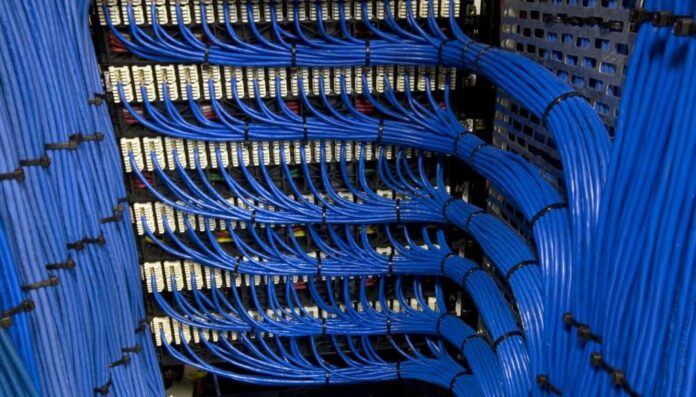Using free tools rather than paid ones, sticking to organic traffic, buying supplies in the lowest prices—these are just a few examples of ways to save your business money. The idea behind these is to avoid allocating budget if possible. That’s precisely why it’s difficult to imagine how structured cabling can save your business money. After all, in order to get a structured cabling system up and running, you have to spend hundreds if not thousands on the preparations.
However, while it does require a certain amount of investment, the implementation of structured cable solutions can save you a lot more money than you will ever spend on the project.
This article will cover seven ways structured cabling saves your business money. But before you get to the meat of the topic, do you know how structured cabling system works?
What Is A Structured Cabling System?
A structured cabling system is a type of infrastructure wherein all the cabling of an organization is unified in a single system. This means all PCs, mobile phones, and other devices (e.g., security alarms, HVAC systems, speakers, etc.) used by the business is held together in one system.
As one might imagine, a system where most of the cabling components are situated in one place makes things more convenient, but more importantly, it can save you money, and here’s why.
1. It Can Reduce Business Downtime From Cabling Issues
There’s a popular saying that time is gold, which is true most of the time, especially when it comes to businesses. In fact, surveys suggest that for every minute a business stops operating due to IT issues, the company loses around USD$100. This number may vary depending on the size of the company. In the case of large companies, this can even go up to USD$5,000 per minute.
Unfortunately, issues resulting in downtime is fairly common, particularly in the IT department. Of course, the causes may vary, but some of them result from an unorganized cabling structure.
However, with a structured cabling system, grouped them using coloured cable ties. it’s less likely to face issues, seeing as how the cables are all organized and not all over the place. If there is an issue, troubleshooting is easier since the inspector knows where to look at to fix the problem. In other words, downtime is less likely and is more manageable, which essentially saves you the money you would’ve lost. If you are in Australia and looking to buy coloured cable ties online check this website for coloured cable ties australia.
2. Structured Cabling Can Minimize Installation Time
Apart from reducing troubleshooting time, a structured cabling system is also more flexible, meaning you don’t have to overhaul the entire system to make changes to the network.
While this may not seem as helpful for your finances, you must remember the when installing a new feature on your cabling system, business operations are often put to a halt.
This means your business is in downtime. For that reason, it’s an excellent idea to lower the installation time, as you’re essentially minimizing downtime by doing so, which then allows you to save money. Moreover, this characteristic of structured cabling is particularly useful when moving to a new office location as you’re able to take apart your existing cabling system more easily.
3. You Can Effectively Reduce Power Loss
All electrical cables are ironically resistant to electricity to some extent. This feature ensures that the cables don’t overheat due to the excessive electricity when connected to a device. Although it’s useful for preventing overheating and prolonging the lifespan of cables, it also means that a certain amount of power is lost as electricity goes from one end of the cable to the other.
Experts call this power loss, and the greater it is, the more you’re losing in energy, which translates to lost money. Therefore, it’s advisable to reduce power loss as much as possible.
One of the most best ways to reduce power loss is by reducing the distance from one end of the cable to the other. And as you may have guessed, a structured cabling system can lead to this outcome, especially since the aim of such system in the first place is to cram all the cabling components into one place. By minimizing the travelling distance from each component, you’re effectively reducing power loss, thereby minimizing the energy bills of your business.
4. Structured Cabling Can Support Numerous Functions And Features
Structured cabling systems are generally built with higher bandwidth than most system. For your reference, bandwidth in cables refer to the range of frequency used to transfer information. The higher or broader this bandwidth, the more data the cable can carry. This means structured cabling can carry large amounts of data. So, what does this have to do with saving money?
For starters, if a cable can carry large amounts of data, that means it can support all sorts of functions with limited disruptions, be it video conferencing or audio transmission.
Since structured cabling is inherently characterized with high bandwidth, you no longer need to upgrade your current cabling system, which effectively saves your business money.
5. It’s Easier To Secure A Structured Cabling System
The cabling system is one of the easiest parts of the business to corrupt. With the right tools and knowledge, hackers can redirect resources used by the cabling system for other, potentially unethical purposes. And as you might expect, attacks on your cabling system can be detrimental to your finances. Fortunately, structured cabling is generally easier to secure than other system.
Moreover, structured cabling systems usually have unique security functionalities and features, which further increases the security of the system and lowers the likelihood of cyber attacks.
6. It Has A Much Better Performance
Structured cabling typically has better overall performance than most cabling infrastructures. Its data transfer rate is higher, connections are more reliable, and loading times are quicker.
While some may argue that these do not affect your finances and cannot save your business money, they most certainly improve the productivity of your employees, which in turn maximizes your potential revenue. It may not save you money directly, but a better-performing cabling system helps with you finances, one way or another.
Final Words
As helpful as it may be to your finances, a structured cabling system won’t always save you money, especially if you don’t have anyone to properly set up and utilize the system. With that said, if you’re planning to implement structured cabling for your business, you might want to look for someone who has a lot of experience in this particular task.








